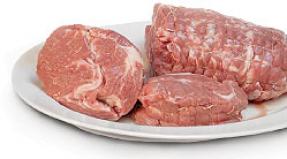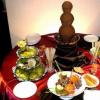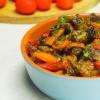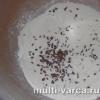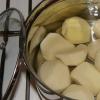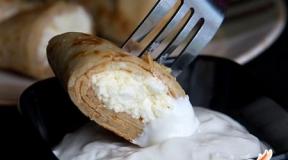National hot dish. The best national dishes of the world
The cuisine of each country has certain characteristics that are unique to it. Often, gastronomic masterpieces become a national treasure and attraction along with museums, monuments and architectural structures.
Tourists who come to this or that country to get to know the habits, culture and customs of unfamiliar people even better try local cuisine. And national delicacies can tell much more about the people than the usual tourist entertainment.
Today it is not at all necessary to travel to get acquainted with the cuisine of another country. You can also do this at home by mastering a few recipes.
We are learning how to cook 10 delicious national dishes from different countries, which have already won the love of gourmets around the world.
1. Pizza
Italian pizza has long emigrated from the country and is being prepared all over the world today. This is exactly the dish from which it is almost impossible to get tired, because you can experiment endlessly with fillings.
You can buy pizza dough in the supermarket or make it at home. Of course, the latter option is preferable if you want the dish to be as tasty as possible and melt in your mouth. How to make the dough yourself, read in.
Let's try to make summer pizza with chicken, bacon and strawberries. Hearty and delicious!
Ingredients:
- Pizza dough 300 g
- Mozzarella 250 g
- Boiled or fried chicken breast 200 g
- Smoked bacon 4 slices
- Red onion 1 PC.
- Strawberry jam (not very sweet) 1/3 cup
- Balsamic vinegar 1/4 cup
- Chili sauce 1 tsp
- Cilantro 5 sprigs
- Strawberries 8-10 berries
- Semolina 2 tbsp. l.
Cooking method:
- Place a metal baking sheet on the middle level of the oven and preheat it to 225 degrees.
- Fry the bacon in a skillet until crispy. Transfer to paper towels to absorb excess oil. Break the bacon into small pieces.
- Pour balsamic vinegar into a saucepan. Bring to a boil, then reduce heat and simmer for 4-5 minutes, until the liquid is half reduced. Add strawberry jam and hot sauce, mix well. Remove sauce from heat and cool to room temperature.
- Roll out the pizza dough into a circle with a diameter of about 35 centimeters. Sprinkle a piece of baking paper with semolina and transfer the dough to it.
- Peel the onion and cut into thin half rings. Cut the chicken fillet into small cubes and mix with 2 tablespoons of balsamic sauce.
- Pour the rest of the sauce on top of the dough and distribute evenly, leaving 2 centimeters free on each edge. Place the chicken on the dough.
- Sprinkle chicken with 3/4 of the cheese and then spread the bacon and onion evenly. Sprinkle with the remaining cheese.
- Transfer the pizza to a hot baking sheet in the oven and bake for 8-10 minutes, until the cheese is melted and the edges of the dough are golden brown.
- Remove the pizza from the oven and let cool slightly.
- Chop the strawberries and finely chop the cilantro. Sprinkle the pizza with cilantro and strawberries and serve immediately.
2. Burgers
Classic American food is loved by residents of completely different countries of the world. Indeed, burgers are tasty, nutritious, satisfying. Such a dish is very helpful when you need to have a quick snack and restore the spent energy.
Ingredients :
- Chicken breast fillet 2 pcs.
- Ground coriander 1 tsp
- Grated ginger 1 tbsp l.
- Mayonnaise 4 tbsp l.
- Mix of lettuce leaves 1 bundle
- Chili pepper 1 pc.
- Lemon 1 pc.
- Fresh mint 1 tbsp l.
- Cucumber 1 pc.
- Sesame buns 4 things.
Cooking method:
- Rotate the fillets in a meat grinder or food processor. Mix the minced meat with spices. Blind 4 patties.Fry them over high heat for 6-8 minutes.
- Mix mayonnaise and mint leaves together. Drizzle over the sesame buns cut in half from the inside.
- Top with a cucumber cut into thin slices with a peeler, lettuce and chicken cutlets.
- Serve with sauces to taste or French fries.
3. Paste
Another delicious Italian dish that is served in top restaurants around the world today is pasta. It can be different and you can endlessly experiment in the kitchen, delighting your family. Try making pasta
Ingredients:
- Zucchini 40 g
- Cherry tomatoes 40 g
- Canned Tomatoes 75 g
- Paste (penne) 80 g
- Garlic 5 g
- Asparagus 45 g
- Parmesan 10 g
- Tobasko 1 tbsp. l.
- A pinch of salt
- Pinch of black pepper
Ingredient List:
- Dip the penne in boiling salted water and boil al dente. Drain the water.
- Wash the asparagus and boil in salted water for 3-4 minutes.
- Rinse garlic, zucchini, tomatoes with water. Cut the garlic into small pieces, the zucchini into cubes and cut the tomatoes in half.
- Pour olive oil into a frying pan, add chopped garlic, lightly fry.
- After a while, send the zucchini and tomatoes to the pan. Fry for 5-7 minutes.
- Put the boiled asparagus in a frying pan and fry for 3-5 minutes.
- Put canned tomatoes in a blender, grind into a homogeneous mass and pour into a frying pan.
- Add salt, pepper and sauce and simmer for another 1-2 minutes.
- Then place the penne in a skillet and simmer for 2-5 minutes.
- Put the finished pasta on a plate and sprinkle with coarsely chopped Parmesan before serving.
4. Paella
The classic Spanish paella is prepared with seafood and served in large pans. If you love trying new things, then repeat this recipe at home and have a Spanish food party.
Ingredients:
- Rice 700 g
- Tomatoes 3 pcs.
- 1/4 cup olive oil
- King prawns 500 g
- Garlic 1 clove
- Parsley to taste
- Mussels 600 g
- Green peas 1 can
- Bow 1 pc.
- Salt to taste
- Pepper to taste
- Red pepper 1 pc.
- Green pepper 1 pc.
- Saffron 1 tsp
- Water 2 l
- Squid rings 300 g
Cooking method:
- Boil the shrimp in salted water. In another saucepan, boil the mussels in boiling water for 5 minutes, until they open.
- Strain the mussel broth and mix with the shrimp broth. Add saffron.
- Pour the olive oil into the paella skillet and heat the skillet. Add finely chopped onion and sauté over low heat. Then add chopped garlic.
- Peel the tomatoes and cut them into cubes with the green bell peppers. Send vegetables to the pan.
- Add squid rings and dry a little.
- Boil rice until half cooked. Send it to the frying pan. Fry for 5-10 minutes, stirring occasionally.
- Pour broth over the cooking dish and bring to a boil. Reduce heat and simmer for about 20 minutes, adding more broth if necessary. Do not stir the rice any more.
- Add the shrimp 5 minutes until the paella is done.
- Slice the red bell pepper lengthwise and send to the pan.
- Sprinkle the paella with chopped parsley, add mussels and green peas.
- Cover the paella with foil before serving and leave to rest for 5 minutes. Then you can serve the dish to the table.
5. Borsch
Flavored borscht, a traditional first dish in Ukrainian cuisine, has gained popularity for its delicious taste. It was borscht that glorified the cuisine of the Eastern Slavs around the world. Learn to cook this dish correctly.
Ingredients:
- Beef brisket on the bone 500 g
- Pork lard 200 g
- Medium onion 3 pcs.
- Beets 2 pcs.
- Potatoes 2 pcs.
- Carrots 2 pcs.
- Head of cabbage 1/2 pc.
- Garlic 4 cloves
- Parsley 1 bunch
- Tomato paste 2 tbsp l.
- Apple cider vinegar 1 tbsp l.
- Bay leaf 1 pc.
- Pinch of sugar
- Salt to taste
- Black pepper to taste
- Sour cream for serving
Cooking method:
- Place the brisket in a 5 liter saucepan. Cover completely with cold water and place over medium heat. Remove foam, reduce heat, add 1 teaspoon of salt and bay leaf. Cook for 1.5 hours.
- After this time, remove the brisket, cut the meat from the bones into small pieces and return to the broth (bones are not needed).
- Preheat a frying pan. Put in half the bacon, and after 3 minutes add the onion. Fry, stirring thoroughly, for 5-7 minutes.
- Then add carrots grated on a coarse grater, mix and fry for 5 minutes.
- In another skillet over low heat, fry the remaining bacon. Add beets, sugar and vinegar there. Fry for 10 minutes, stirring thoroughly. Then add tomato paste to the beets and fry for another 2 minutes.
- Peel and cut the potatoes into cubes. Chop the cabbage finely.
- Bring broth to a boil and add potatoes. Cook over low heat for 3 minutes. Then add the cabbage and cook for another 5 minutes. Then add carrots with onions and beets. Cook the soup over low heat, covered, for about 10 minutes.
- Peel the garlic. Chop with parsley as small as possible and add to the borscht.
- Close the lid, turn off the heat and let the borscht brew for 10 minutes. Serve with sour cream.
6. Rolls
Today, Japanese cuisine is no longer exotic. Delivery of sushi and rolls is available almost everywhere, and some even prepare these delicacies themselves at home. You will learn too. Mastering the "Philadelphia" recipe.
D To make rolls at home, you will need a bamboo mat and cling film.
Ingredients:
- Rice for sushi 350 g
- Water 360 g
- Rice vinegar 80 g
- Dried nori seaweed 1 package
- Lightly salted trout or salmon 1 package
- Philadelphia cheese" 300 g
- Wasabi for serving
- Ginger for serving
- Soy sauce for serving
Cooking method:
- Cook rice for sushi, strictly following the directions on the package.
- Cut a whole nori sheet in half. Repeat the same with other sheets from the package.
- Carefully wrap the mat in plastic wrap to avoid unnecessary contamination.
- Cut the fish into thin slices of approximately the same thickness and length.
- Place the mat in front of you. Place half of the nori sheet, smooth side down, on the part of the mat closest to you.
- Spread the rice on the nori in a thin layer. Before taking a new batch of rice, you need to moisten your hands in cold water. Leave the nearest edge of the nori 1 centimeter free.
- Cover the rice and nori with the other half of the mat and turn the mat with the nori, pressing it lightly with the palm of your hand. Unfold the mat - the rice should be on the bottom and nori on the top.
- Put the cheese in the middle of the nori. Leave the edges empty, otherwise the cheese will climb out during the folding of the roll.
- Roll up the roll, pressing the mat firmly against the nori. Give the roll a round shape.
- Place the fish slices close to the rolled roll. Use a mat to wrap the roll in the fish.
- Cut the roll into pieces with a sharp knife. It is necessary to moisten it every time with cold water so that the rolls do not fall apart.
- Serve with wasabi, ginger and soy sauce.
7. Onion soup
An iconic dish of French cuisine, which is tasted by almost all tourists, without exception, when they find themselves in Paris. But what if there is no opportunity to go to France yet? Cook it at home.
Ingredients:
- Semi-hard or hard cheese 100 g
- Onion 500 g
- Butter 50 g
- Sugar 1 tbsp. l.
- Flour 1 tbsp. l.
- Meat or chicken broth 1.5 l
- Port wine 2 tbsp. l.
- Baguette slices to taste
- Salt to taste
- Black pepper to taste
Cooking method:
- Thinly cut the onion into half rings. Melt the butter in a heavy-bottomed saucepan andwithin 20 minutesover medium heat, cook the onion, stirring often so that it does not burn, but only becomes golden and soft. Season with salt and pepper.
- After this time, sprinkle the onion with sugar, flour and cook, stirring for another 10 minutes.
- Pour half of the hot broth over the onion and bring to a boil. Simmer for 15 minutes. Then add the rest of the broth and port and cook for another 30-40 minutes.
- Pour the soup into refractory bowls or pots. Spread out the slices of bread, drowning them slightly so that they are slightly wet on both sides.
- Sprinkle the soup with grated cheese and bake under the grill or in an oven preheated to 180 degrees until the cheese forms a golden brown. This is about 5-7 minutes. Serve immediately.
8. Dumplings
It is not possible to determine the exact geographical origin of the dumplings. In general, this is a Russian cuisine dish with ancient Chinese, Finno-Ugric, Turkic and Slavic roots.
Today dumplings are extremely popular in Russia. And it is not surprising, because homemade dumplings are a real work of art.
Ingredients:
- Eggs 1 pc.
- Water 1 glass
- Salt 1 tsp
- Wheat flour 600 g
- For filling:
- Ground beef 250 g
- Minced pork 250 g
- Onion 1 pc.
- Garlic 1 clove
- Salt to taste
- Black pepper to taste
Cooking method:
- Sift flour with a slide. Make a depression on top, pour an egg and 1 tablespoon of water into it. Add a pinch of salt.
- Gathering the flour from the edges to the middle so that the water and egg do not pour out of the cavity, knead the dough, adding the remaining water in small portions. Knead the dough until elastic and smooth, about 10 minutes. Cover with a damp towel and leave for half an hour. The water for the dumplings should be ice cold. To do this, you need to put it in the refrigerator in advance.
- While the dough is settling, you need to prepare the filling. Peel the onion and garlic and chop very finely. Mix the ground beef and pork. Add onion and garlic to the filling. Season with salt and pepper. Mix thoroughly until smooth.
- Divide the finished dough into 4 parts, cover 3 parts with a damp towel and set aside. Roll the remaining dough into a rope 2 centimeters thick. Cut it into slices about 1.5 centimeters wide. On a floured surface, roll each piece of dough into a thin cake.
- Place 1.5 teaspoons of the filling in the center of each flatbread. Fold the filled circle in half so that you get a crescent moon. Connect the ends of the crescent and hold them together. For the ends to stick well together, you need to press them tightly with your fingers.
- Place the dumplings on a tray or flat dish, sprinkle with flour and refrigerate. Prepare dumplings from the remaining dough in the same way.
- The dumplings must be boiled or frozen immediately.
Each nation has its own special national cuisine. And in each such cuisine, you can find the peculiarities of the culture of the people, passed down from generation to generation. Of course, in order to appreciate all the subtleties of various dishes, you need to go to this or that country. And visit both chic restaurants and small family restaurants, where this or that dish is prepared in a special way. We really hope that you will find something special for yourself or share your experience.
Welcome to a gastronomic tour of the world's cuisines! We have collected for you a considerable collection of dishes imbued with the spirit of different countries. Cooking is an important part of culture. Recipes for national dishes have been lovingly passed down from generation to generation until they have survived to this day. And now you have the chance to set your own multicultural table by preparing sumptuous meals at home!
Recipes from around the world at your fingertips
There is no way to fly to France for a rooster in wine or to Thailand for coconut soup with ginger? And you don't have to get on a plane for a new culinary experience! Try to cook exotic dishes yourself. In this section, you will find the best recipes from dozens of different countries. Among them are not only popular, but also more unusual cuisine for us.
The list of traditional dishes on our website is made up of culinary masterpieces from all over the world:
- European cuisine (Bulgarian, Belarusian, French, English, German, Ukrainian, Russian, Belgian, Greek, Spanish, Italian, Hutsul).
- Balkan cuisine (Finnish, Scottish, Latvian).
- Asian (Thai, Chinese, Japanese, Indian, Vietnamese, Korean).
- Eastern and Arabic (Turkish, Jewish, Lebanese, Tatar and Bashkir, Uzbek, Abkhazian, Azerbaijani, Georgian, Armenian).
- Cuisine of the Americas (Indian, Canadian, American, Mexican, Hawaiian, Colombian).
- Australian cuisine;
- Egyptian cuisine.
The selection of recipes is very wide! Prepare a dish that suits your mood and ingredients. Spoil yourself with a mouth-watering beef carpaccio or surprise the family with Georgian khinkali.
Features of the cuisine of different nations
All peoples are different, and the cuisine of each nationality has its own subtleties. Yes, to try the perfect cacamber with garlic or chestnut soup, it is better to go to one of the French restaurants. But if you make an effort, you can achieve an amazing similarity! The main thing is the most understandable and sorted recipe.
Illustrative photos are attached to each recipe on our website, which will help you to exactly repeat the culinary masterpiece. In all the instructions, the necessary actions are described step by step so that you do not rack your brains over the cooking process. You will definitely succeed!
Pick a recipe, cook, enjoy. Don't forget to experiment and share your own recipes!
In any country there are culinary preferences that have been formed by more than one generation. National traditions of different countries of the world depend on many factors. Naturally, the recipes for each region are based on the use of certain foods and spices available. The cooking method also plays an important role. It should be noted that each nation has its own characteristic taste preferences. And many dishes are generally a real national pride, the fame of which has spread throughout the world. We want to devote our article to a conversation about national dishes from different countries of the world. Their diversity and uniqueness are sometimes simply amazing. And sometimes it turns out that our favorite food or bun is someone else's culinary invention, which has reached our latitudes.
French cuisine
Traditional French cuisine is based on the use of simple products, from which complex dishes are ultimately obtained. In France, fish, shrimps, lobsters, vegetables, meat and, of course, excellent cheeses - Camembert, Roquefort and others - are widely used.
Some of the most sensational are snails and frog legs, without which it is impossible to imagine the original cuisine. Well, and, of course, it is worth remembering the wonderful wines that complement any meal.
The most famous French food
Traditionally, the French morning starts with an omelet. It was from France that it came to us. It is prepared quite simply - beaten eggs are fried in oil in a pan. The omelet can be fluffy and flat, rolled or doubled. This national dish of France has gained popularity all over the world; now it is difficult to find a country in which it would not be cooked. By the way, the first mentions of him are found in manuscripts dating from the sixteenth century. But it acquired its modern form already in the eighteenth century.
No less popular are the famous croissants, which are puff bagels. Traditionally, such pastries are served for breakfast. Croissants have gained such universal love that they are now one of the staples of all bakeries and pastry shops in Austria and France. Of course, the most delicious pastries are prepared by real confectioners. But you can also find such a dish in fast food establishments. It is known that for the first time such buns began to be prepared by Austrian confectioners, but they gained popularity in France. To prepare delicious delicacies, a variety of fillings are used - fresh fruits, chocolate, pralines, dried fruits, etc.
The escargot dish is very popular and quite expensive. It is served in restaurants. The appetizer is prepared on the basis of edible snails. The French consider Burgundy to be the most delicious. In general, the dish belongs to the category of delicacies.
Ratatouille
One of the most famous dishes in France is ratatouille. The dish is very simple to prepare and incredibly tasty at the same time. Gradually, it earned love all over the world, far beyond France. In a modern version, ratatouille is unthinkable without olive oil and Provencal herbs. There are a lot of recipes for the dish today. In the classic version, for cooking, you need to take: one bell pepper, six tomatoes, a few chives, zucchini or zucchini, dill, olive oil, salt, parsley.

For the sauce, you need to chop two tomatoes, an onion and a pepper. Put all the vegetables in a preheated pan and fry in olive oil for about ten minutes. Add salt and pepper. Transfer the finished sauce to the bottom of the ratatouille mold. By the way, some culinary experts recommend chopping the sauce with a blender.
Cut the zucchini and the remaining tomatoes into slices and place them in a cooking dish. In this case, it is necessary to alternate tomatoes with zucchini. Sauce is prepared for dressing the dish. To do this, combine chopped herbs, olive oil and garlic. Pour vegetables with sauce, add pepper and salt. Cover the dish with foil on top. And we send it to the oven. We bake vegetables for about an hour.
German cuisine
All national cuisines of the world have their own characteristics. German was no exception. For many, German cuisine is associated with beer, sauerkraut and sausages. However, this is far from the entire range of products used by local residents. National ones are quite interesting and varied.
The Germans are very fond of pork. In general, meat dishes have a special place in the local cuisine. The chefs prepare excellent sausages. By the way, egg dishes are incredibly popular in Germany. Snacks are prepared from them, stuffed, omelets are made, baked, combined with various products.
Each region of the country is famous for its characteristic dishes.
Black forest cherry

Black Forest Cherry chocolate cake is a national dish of Germany, which is known far beyond the borders of the country. We know the sweetness better under a different name - "Black Forest". To prepare cakes for dessert, you should take: flour (110 g), sugar (110 g), eggs (6 pcs.), Chocolate (60 g), baking powder (teaspoon), cocoa (3 tsp). But for the cream you will need: good heavy cream (650 g), cherries (470 g), vanilla, powdered sugar (110 g). For cakes, it is necessary to use impregnation, for it we take sugar (3 tbsp. L.), Cognac (4 tbsp. L.), Cinnamon (teaspoon).
To prepare the dough, it is necessary to separate the yolks and whites. The first ones should be beaten with sugar. But whisk the proteins in a separate container until dense peaks. Next, carefully add the mass to the yolks.
Before using flour, it must be sieved with baking powder and cocoa powder. Gradually add the finished dry mass to the beaten eggs. Add ground almonds and grated dark chocolate there. As a result, we got the dough, which we transfer to a greased form. The cake must be baked for about half an hour at 180 degrees. As soon as it is ready, we take it out of the stove and leave it to cool. After that, it will need to be cut into three parts with a knife. We should have three cakes.
Now you can start filling. To prepare it, you need a cherry. You can take frozen or fresh berries, after removing the seeds. The juice can be drained into a saucepan and add cinnamon and sugar. The mass needs to be gradually heated, gradually the sugar will begin to dissolve. Pour cognac, cherry liqueur or whiskey into the mass. We soak our cakes with the resulting syrup.
In a separate bowl, beat the sugar with good heavy cream and vanilla. Put the cherries on the bottom cake, not forgetting to spread the cream between the berries. Put the second cake on top and then repeat the steps with the filling. Next, lay out the last layer. Lubricate the sides of the dessert with the remains of the creamy mass and decorate them with chocolate chips. The finished cake is sent to a cold place for a couple of hours. The top of the dessert is decorated with powdered sugar and candied cherries.
The most popular national dishes from different countries of the world have long become common property, however, having undergone some changes and additions far from their homeland. This is and is loved by many of us.
Kazakh cuisine
Kazakhs are incredibly hospitable people. Perhaps for this reason, Kazakh national dishes are so tasty. After all, no matter why the guest came to the house, he will certainly be invited to drink tea and eat sweets and dried fruits, and the hungry will not be allowed to go. The popularity of Kazakh dishes is confirmed by the fact that restaurants of national cuisine operate all over the world, far beyond the borders of Kazakhstan.
Even the most inexperienced people in cooking have probably heard of such a Kazakh national dish as beshbarmak and manti. The latter outwardly very much resemble our dumplings, but are larger in size. They are steamed in a special container. She is called the mantle. In such a saucepan there is a grate on which the manti is spread.
How to cook manti?
The traditional recipe for this deliciously delicious dish is still used today. In Asia, a mixture of different types of meat is used for cooking. Such a dish has not only a high energy value, but also retains all the nutrients, thanks to the special method of steaming.

The standard recipe uses lamb (about a kilogram). You will also need one egg, water (180 ml), a couple of onions, a glass of flour, a teaspoon of salt, black pepper and caraway seeds.
In a large container, mix the dry ingredients and pour the egg into the middle and add water. Next, knead the dough, cover it with a napkin and leave it for fifteen minutes. In the meantime, you can prepare the filling by finely chopping the meat or passing it through a meat grinder. Add salt, spices and onions. Mix everything thoroughly and add oil.
Roll out the dough into a thin layer and divide it into rectangles. Put the filling in each and fasten the opposite edges of the rhombus. Next, cook the manti in a mantle for about 45 minutes.
Russian kitchen
Pelmeni is a national dish of Russia. And it got into Russian cuisine from the Urals. In general, similar food is present in many national cuisines of the world. And every nation has the right to consider it as originally its own. Ravioli, manti, Georgian khinkali are very similar to dumplings.

If for the preparation of dumplings we, as a rule, take beef or pork, then in Asia they use lamb for their dishes. In addition, manti, as we have already said, is steamed, and ravioli and khinkali are boiled. Of course, such national dishes from different countries of the world have their own characteristics, but at the same time they are all incredibly tasty. The principle of making dumplings is quite similar to the recipe for mantas, with the exception of the heat treatment method and additional components.
Belarusian dishes

National dishes of Belarus have been formed over many centuries. The originality of the cuisine was determined by the geographic and climatic conditions. The closest neighbors had no less influence. In the old days, meat was not used so often, but salted bacon, mushrooms and berries were present. Unlike other Slavic cuisines, there were few sweets and almost no dairy. Berry jelly was used as desserts,
It's no secret that most of the national dishes of Belarus are food made from grated potatoes. One of them is called potato pancakes.
Preparing the dish is quite simple. This will require potatoes (10 pcs.), An onion, salt and vegetable oil. The potatoes are peeled, washed and grated. Add onion, salt and mix all the ingredients well.
Next, in a hot frying pan, pancakes are fried in vegetable oil. The dish is served hot with sour cream on the table. In addition, you can offer sour cream-apple sauce or sour cream-onion sauce to the pancakes. The dish is also prepared with meat, mushrooms and sausages. As a rule, the recipes are quite simple and it is not difficult to prepare them.
Ukrainian food

It is very varied and represented by a rich selection of dishes. Many of them have been prepared for a long time in many countries of the world, but they are still associated with Ukraine. The most famous national dish of Ukraine is borscht. No less famous are dumplings, salted bacon, pickle, cracklings, cheesecakes, roast, etc.
Ukrainian borscht recipe
To prepare such a national dish as Ukrainian borscht, you need to take: meat (preferably pork 550 g), half a head of cabbage, potatoes (5-7 pcs.), Onion, pepper, a couple of carrots, tomato, garlic and herbs.
The dish is prepared quite simply. First, we cut the meat, cut it into portions and fill it with cold water. Next, we cook it until it is semi-ready. In the meantime, we clean and cut the potatoes into cubes, chop the cabbage and chop the carrots, onions, beets. Fry the carrots in vegetable oil in a frying pan, then add the onion, and then chopped pepper. Add the tomato diluted with water to the vegetables, and continue to simmer the dressing for the dish.

We send potatoes to a saucepan with broth, and a little later we put cabbage. As soon as the vegetables are almost ready, the borsch dressing can be transferred to a container with liquid. Next, cook the dish until cooked, not forgetting to put the chopped greens shortly before the end of cooking. The dish must certainly be infused, then it becomes much tastier. You can serve borscht with sour cream and garlic.
National cuisine is one of those things that people do. In general, acquaintance with the local cuisine is quite an interesting and sometimes even dangerous occupation. Our review will allow you to learn more about the most exotic dishes, without having to try them.
1. Salmon sweets, Finland

Finland produces a wide variety of sweets, but salmiak sweets are something that every tourist who comes there should try. Fancy lozenges are made from ammonia and hydrochloric acid. Traditional Finnish salmiakki are available in the form of a rhombus or deep black diamond.
2. Hatinooko, Japan

In Japan, bee larvae are a very popular and gourmet dish. They are boiled with added sugar and soy sauce, canned, fried on skewers like kebabs, and sushi is made with them. Also worth mentioning are the rice biscuits with crunchy ground wasps.
3. Natto, Japan

Natto is a fermented soybean that has a specific smell and taste, as well as a sticky, viscous consistency.
4. "Oil bombs for a brave heart", USA

The weird dessert is deep-fried butter in honey and cinnamon batter.
5. Jelly salad, USA

Plain fruit jelly with an unusual filling of carrots, peppers, eggs, cheese, lemon tuna, olives and any other ingredients to your taste.
6. Salad with sneakers, USA
A simple, sweet and very “healthy” salad of finely chopped sneakers and fruit, generously dressed with whipped cream.
7. Aspic, Russia

Yes, yes, foreigners are wary of jellied meat, beloved by all Russians and their closest neighbors.
8. Surströmming, Sweden

The peeled herring is salted, placed in an open dish and left to ferment, and after a while it is sorted into cans and ends up on the shelves. Knowledgeable people recommend opening a jar of such herring exclusively in the fresh air, as the aroma can literally knock you off your feet.
9. Wedgeite, Australia

Wedgeite is Australia's most famous national dish. A thick paste made from leftover beer wort and vegetable flavors is most often spread over bread, crackers, or sandwiches.
10. Lutefisk, Norway

Scandinavian cuisine is distinguished by a huge number of fish dishes. One of the national dishes of Norway, Sweden and Finland is lutefisk for cooking, which dried fish is soaked in an alkaline solution of caustic soda for three days, and then soaked in water for several days. Due to chemical reactions, the fish acquires a delicate jelly-like consistency and a specific pungent odor.
11. Olive bread, USA

A meatloaf like a loaf of bread stuffed with spices and olives.
Russian cuisine is incredibly tasty and satisfying, striking with a variety of dishes and unique gastronomic combinations. It is not for nothing that Jean Anthelme Brija-Savarin, a famous French gourmet and author of the book "The Physiology of Taste", considered only three cuisines great, including the Russian one. For many centuries in a row, it has been an integral part of the culture and a marker of the historical authenticity of the Russian people. Let's remember the primordially Russian dishes, the tradition of which has survived to this day.
Russian roast
The first mentions of this dish date back to the reign of Tsar Alexei Mikhailovich. Then the roast was served second after the traditional soup. The essence of the dish is easy to catch thanks to the root "heat" - which means that it is languished in the oven for several hours.For this purpose, any fatty cuts of meat are perfect, which are supplemented with potatoes, cut into large pieces. By the way, Russian roast is the only dish awarded a title of nobility. It received it thanks to the admiration of the English king Charles II. He was so impressed with the taste of the roast beef that immediately, right at the table, he awarded him a high title.
Porridge
Porridge in Russia is not just a hearty meal, but a philosophy of life. It was porridge that was the main dish on the table of our ancestors for several centuries in a row. It was eaten with pleasure by the poor and the rich, and the great reverence for this dish can be easily identified by the ancient saying "Porridge is our mother." 
Previously, porridge was called anything that could be prepared from chopped food. Today we are happy to use wheat, millet, pea, buckwheat and other types of cereals. And for Christmas and for funeral dinners, it is still customary to cook kutya - porridge made from wheat or rice with the addition of honey, poppy and raisins.
Cabbage soup
This first course has a short name and a long history. Knut Hamsun, a well-known Norwegian writer, called it "an unacceptably nasty meat soup" and, at the same time, "a wonderful Russian dish." Indeed, cabbage soup is very contradictory both in taste and composition. 
The inhabitants of Russian villages prepared them in different ways, depending on their income. Some cooked cabbage soup only with onions and cabbage, while others added crushed bacon or meat. Other recipes include rye flour, turnips, mushrooms and fish. And the characteristic sour taste was achieved due to sauerkraut or brine, sorrel, kvass. The editors of the site notes that cabbage soup could well be included in our rating of the most delicious dishes for less than a hundred rubles.
Siberian dumplings
Since dumplings came to Russian cuisine from the Urals, it is not surprising that the Siberian is the most popular variety of them. And although in many countries of the world there are very similar dishes (suffice it to recall Georgia, Italy and China), we consider them a primordially Russian dish. 
In Siberia, dumplings were harvested for many months in advance, since they are wonderfully stored frozen. In the traditional recipe for minced meat, three types of meat are used: elk, pork and beef. Today Siberian dumplings have a more prosaic filling - minced pork and beef, but they are still very juicy and tasty. By the way, it is imperative to use ice water to prepare the dough - this gives it a unique taste.
Pie
"Unbuttoned pies" - this is what pies are called, a traditional Russian pastry made from uncooked yeast dough. At first, these open-top pies were served in inns with soups and stews. Later, they later became an independent dish, for some time leading in the format of street trading. 
The editors of vnizyvsё.rf notes that historically pies were made from leftover food: they put inside what was left after dinner. But most of all were appreciated pies with fish filling: minced river fish, pieces of sturgeon, salmon or beluga. An open pie was poured over with melted butter or hot broth, which made it even more delicious and juicy.
Pancakes
Initially, pancakes were a ritual dish - they were prepared for the memorial table, and later also for Shrovetide. But today these thin flat cakes, reminiscent of the sun, have become a full-fledged Russian dish without any subtext. Pancakes are mentioned in many proverbs and sayings, which once again emphasizes their popularity (for example, "The first pancake is lumpy"). They are prepared with yeast and unleavened dough, brewed with milk and water, baked in a pan and in a traditional Russian oven. 
Pancakes with butter and dozens of fillings are very tasty: mushrooms, meat, cabbage, potatoes, liver, cottage cheese and caviar. And also pancakes became the basis for making kurnik - in this unique pie thin pancakes are filled with chicken and mushrooms filling, and then covered with a “cap” of flaky text. Kurnik is the king of pies, it is also called royal or festive. Very often it was served at weddings and other special events.
Boiled pork
This hearty meat dish was mentioned in the pages of Domostroi, compiled in the 16th century. However, at that time not everyone could afford it, because it was prepared from a whole piece of pork, less often - lamb or bear meat. Marinated and then baked boneless meat was originally called "vuzhenina" (from the word "wood" - smoke, dry). 
Today, as before, boiled pork is served hot and cut into thick slices so that guests can eat from the heart. However, as an appetizer, it is also good cold, so the hostesses often cook it a day or two before the festive event.
Kvass on rye bread
Our ancestors prepared it from a wide variety of ingredients, due to which it had a sour or sweet taste, dark or light color, different harshness and aroma. But kvass on rye bread is considered traditional. It's amazing how delicious this drink, made with rye crusts, yeast, sugar and raisins, can be! It also not only quenches thirst well, but is also used for medicinal purposes. For example, kvass has a beneficial effect on the digestive system. 
Pozharsky cutlets
The Pozhansk cutlets have an interesting legend associated with Emperor Nicholas I - he allegedly tasted them while visiting Daria Pozharskaya's tavern. She did not have chopped veal cutlets ordered by the sovereign, but she found minced chicken, which became the main part of this tasty and delicate dish. The secret of fire cutlets is that chopped butter is added to the meat, which melts during frying and makes them unusually tender. Russian national summer soup - okroshkaThere are a lot of recipes for its preparation, but in most cases it contains boiled meat (as an option - boiled sausage), radish, fresh cucumber, potatoes, chicken eggs, green onions, dill or parsley. And for dressing, they use low-fat kefir, whey, vegetable broth, kvass and even mineral water diluted with sour cream.
Any national culture is rich in unusual traditions that relate not only to cooking, but also to many other areas of life. So, from generation to generation are passed (although sometimes very dubious) folk recipes for medicines for anything. The editors of the site invites you to read about the strangest and most dangerous medicines for serious diseases.
Subscribe to our channel in Yandex.Zen


